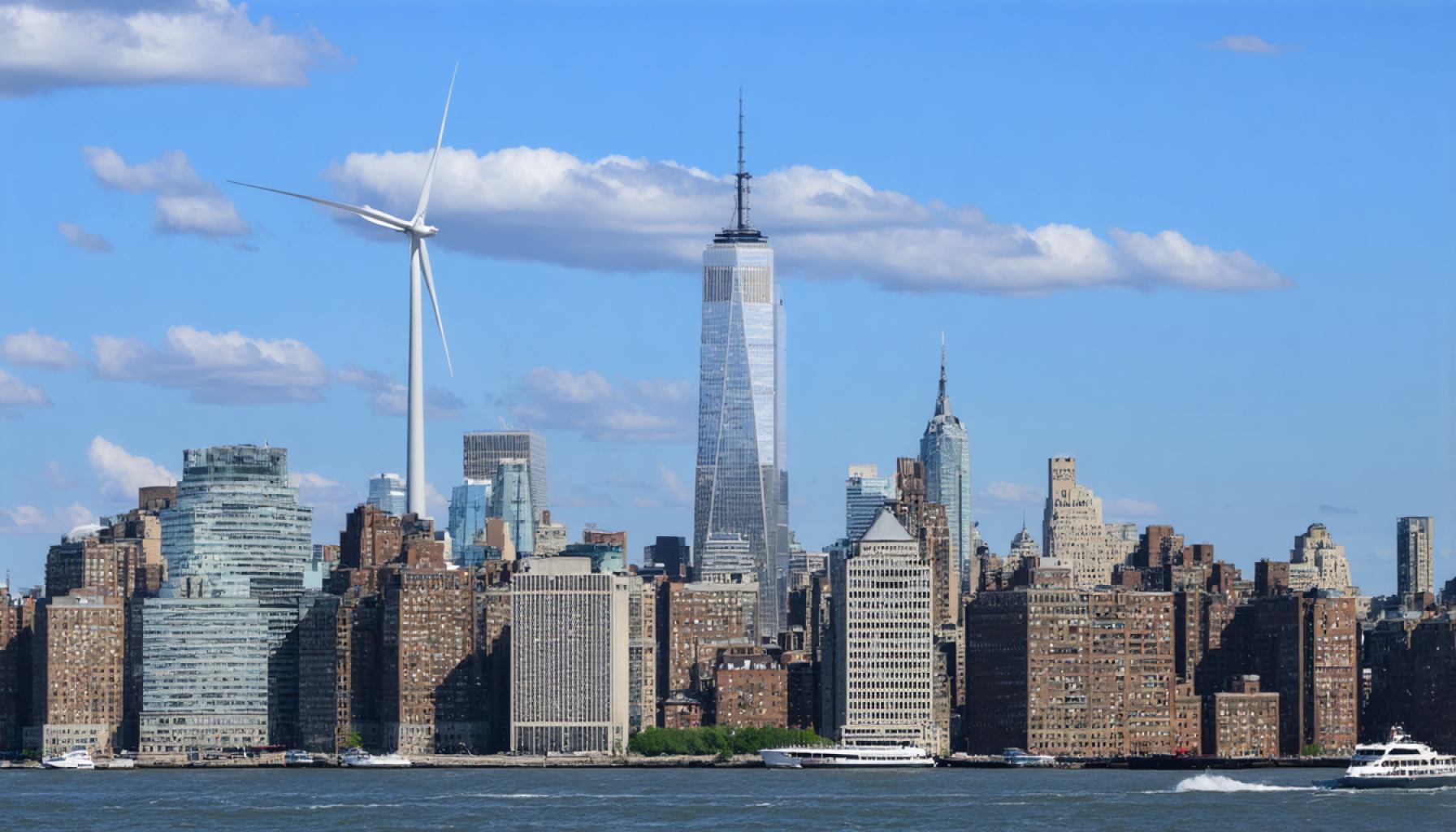- New York State is striving to reduce greenhouse gas emissions, aiming for major reductions by 2030 and 2050 under the Climate Leadership and Community Protection Act.
- A majority of New Yorkers support sustainable energy but are reluctant to incur significant costs; 60% oppose paying more than $10 extra monthly for clean energy initiatives.
- The tension between environmental goals and economic affordability is evident across demographics, affecting energy pricing and legislative action.
- Public awareness of the Climate Act is low, with nearly half of residents unaware of it, highlighting the need for increased education and engagement.
- The challenge lies in balancing New York’s environmental ambitions with economic concerns, requiring collaborative innovation between policymakers and citizens.
- The future relies on harmonizing ecological aspirations with fiscal realities, charting a sustainable yet affordable path forward.
As New York State races against time to curb greenhouse gas emissions, its residents find themselves standing at a crossroads. Imagine a bustling cityscape, where the future hums with the potential of wind turbines and solar panels, yet the journey to this green horizon is fraught with financial hesitation. A recent survey by the Empire Center for Public Policy paints a vivid picture of this reality. Though the majority of New Yorkers champion efforts toward sustainable energy, many balk at the idea of footing a hefty bill. An overwhelming 60% of respondents express reluctance, even outright unwillingness, to pay more than a token amount—less than $10 monthly—to support clean energy initiatives.
The survey’s findings resonate with the dichotomy of environmentalism versus affordability. Most New Yorkers dream of emission-free skylines, yet three-fifths prioritize maintaining current energy prices over aggressive carbon reduction. This sentiment rings true across age, income, and political spectrums, revealing a core truth about the state’s populace: the quest for sustainability is tempered by economic pragmatism.
This pragmatic stance gains particular significance as New York’s lawmakers grapple with implementing the ambitious Climate Leadership and Community Protection Act. This sweeping 2019 legislation aims to slash emissions by 40% by 2030 and 85% by 2050, relative to 1990 levels. The legal complexities grow as green groups push for swift action, urging compliance through the judiciary, even as Republicans argue for broadening the clean energy palette with alternatives like renewable natural gas and green hydrogen.
Despite the looming environmental targets, the chasm of unfamiliarity with the Climate Act is stark among residents. Nearly half remain oblivious to its existence, while only a scant 12% claim familiarity with its promises and obligations. This disconnect highlights the critical need for public engagement and education—vital components of a sustainable shift.
While certain political figures advocate vigorously for a fossil-fuel-centric agenda, reducing regulation to fuel economic independence, the essence of the New York challenge remains clear: How does one chart a sustainable course that respects both the environment and the economic pulse of its residents?
In the tapestry of this transition, the enduring message is unmistakable. New Yorkers envision a cleaner, greener future, but their commitment sways with the currents of cost. Finding a harmonious balance between ecological dreams and fiscal reality is no small feat, but perhaps therein lies the true path to a sustainable tomorrow. A task where policy makers and the populace must innovate and collaborate, weaving a narrative that holds affordability and sustainability in equal measure.
Unlocking New York’s Path to Green Energy: Public Concerns and Practical Solutions
How New York Can Balance Green Energy Ambitions and Economic Concerns
New York State stands at a pivotal juncture in its journey toward reducing greenhouse gas emissions. While there is widespread enthusiasm for transitioning to sustainable energy sources like wind and solar, many residents are apprehensive about the financial implications. A recent survey by the Empire Center for Public Policy revealed that a majority of New Yorkers, while supportive of clean energy efforts, are hesitant to incur significant costs, with 60% unwilling to pay more than $10 extra per month for these initiatives.
Key Challenges and Solutions
Understanding the Challenges:
1. Public Awareness: A significant number of New Yorkers are unaware of the Climate Leadership and Community Protection Act, which aims to reduce emissions by 40% by 2030 and 85% by 2050 from 1990 levels. Improved public education could bridge this gap, making the public more receptive to policy changes and their benefits.
2. Economic Considerations: The survey reflects a pragmatic stance among New Yorkers, who prioritize maintaining current energy prices. This highlights the need for cost-effective solutions as part of the state’s energy transition strategy.
3. Diverse Energy Alternatives: Lawmakers face pressure to expand the clean energy portfolio, incorporating renewable natural gas and green hydrogen, which could offer more financially viable options for consumers.
Practical Steps for the Energy Transition
1. Increase Awareness and Education: Launch state-wide campaigns to inform residents about the Climate Act, its goals, and how it impacts their lives. Public forums, workshops, and school programs could be effective ways to boost understanding and participation.
2. Subsidies and Incentives: Implement financial incentives for renewable energy adoption, such as tax breaks for solar panels or home energy efficiency upgrades, which can alleviate the immediate cost burden on residents.
3. Invest in Job Training: Develop programs aimed at training workers for clean energy jobs, which can stimulate the economy and offset potential job losses in fossil fuel industries.
Market Trends and Future Predictions
– Increased Investment in Green Technologies: With policies focused on reducing emissions, investments in green technologies are likely to accelerate. Expect to see growth in sectors such as battery storage, offshore wind farms, and solar panel manufacturing.
– Public-Private Partnerships: Collaborations between the government and private sector firms could drive innovation and efficiency, leading to more affordable and effective energy solutions.
Controversies and Limitations
While there is strong support for green energy, some factions argue for a more balanced approach that includes fossil fuels for economic stability. This highlights the challenge of designing policies that satisfy both environmental and economic goals.
Quick Tips for Residents
– Reduce Energy Consumption: Simple actions like using energy-efficient appliances and LED lighting can lower energy bills and support broader sustainability efforts.
– Explore Community Solar Projects: Participating in local solar initiatives can provide lower-cost access to renewable energy without upfront costs for solar panel installation.
Conclusion: Charting the Path Forward
New York’s journey to a greener future requires balancing ecological aspirations with economic realities. By fostering public engagement, offering financial incentives, and broadening the energy palette, the state can create a sustainable blueprint that aligns with the needs and values of its residents.
For further details on New York’s energy initiatives, visit [Empire Center for Public Policy](https://www.empirecenter.org).
 Why New Yorkers Are Hesitant to Pay for Clean Energy Despite Broad Support
Why New Yorkers Are Hesitant to Pay for Clean Energy Despite Broad Support  An Unexpected Twist in the Battle Against Long COVID: What Scientists Are Testing Next
An Unexpected Twist in the Battle Against Long COVID: What Scientists Are Testing Next  The Unexpected Journey: How A Viral Trend Became a Multi-Billion Dollar Phenomenon
The Unexpected Journey: How A Viral Trend Became a Multi-Billion Dollar Phenomenon  PulteGroup Endeavors to Secure Investor Confidence Amid Dip in Earnings
PulteGroup Endeavors to Secure Investor Confidence Amid Dip in Earnings  The Florida Rocket Launch That Everyone Will Be Talking About: How to Catch It Live
The Florida Rocket Launch That Everyone Will Be Talking About: How to Catch It Live  High-Speed Pursuit on Utah’s I-80: Reckless Rampage Ends in Arrest
High-Speed Pursuit on Utah’s I-80: Reckless Rampage Ends in Arrest  The AI-Fueled Comeback: Can Twilio’s Next Act Revive Its Meteoric Rise?
The AI-Fueled Comeback: Can Twilio’s Next Act Revive Its Meteoric Rise?  The Battle of the Budgets: Why Google’s New Comparison Page Raises Eyebrows
The Battle of the Budgets: Why Google’s New Comparison Page Raises Eyebrows  Is Fidelity’s Stock Decline a Golden Opportunity for Savvy Investors?
Is Fidelity’s Stock Decline a Golden Opportunity for Savvy Investors? 